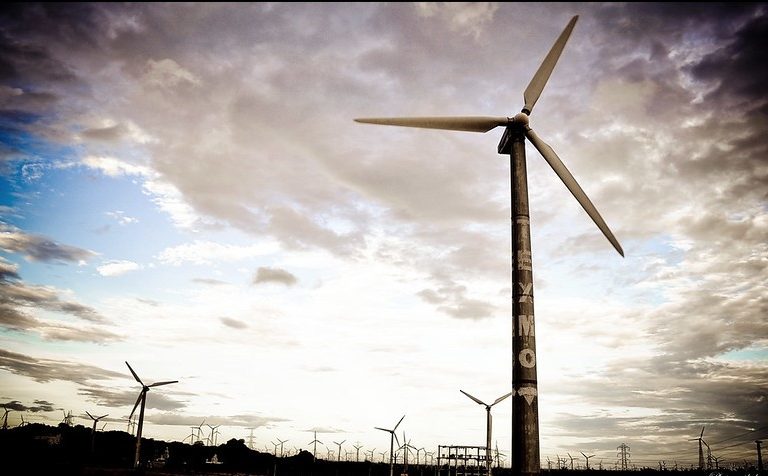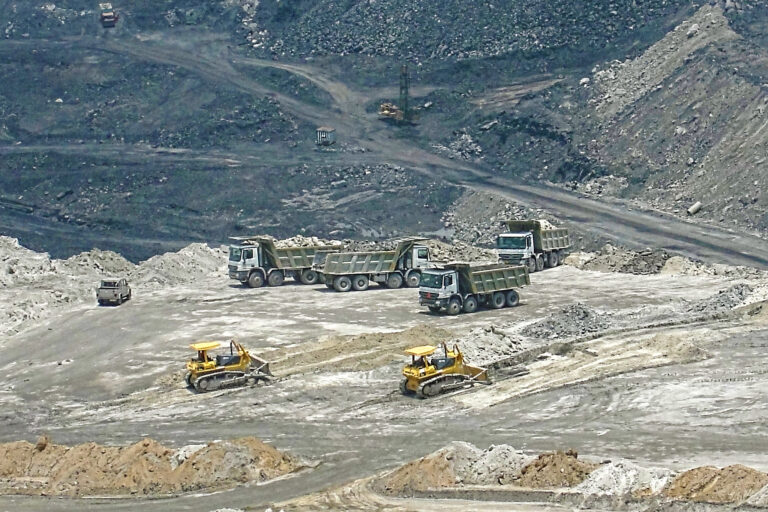- A recent report by a parliament panel said that India needs Rs. 2.61 trillion to install the balance capacity to achieve its target of 175 gigawatts of renewable power by 2022, but is facing financial challenges.
- The report asked the Indian government to address the issues of non-performing assets in the sector and focus on attracting international funds to boost growth.
- Experts say that India needs to send a signal to the investors that it is preparing the market in line with climate change requirements in order to attract vast volumes of institutional and private capital.
As India powers ahead to meet its clean energy goals, it is facing a shortage of funding − trillions of rupees that are needed for the growth of the renewable energy sector.
India has a target of 450 gigawatts of installed renewable energy capacity by 2030 and 175 GW by 2022. But this clean energy transition script lacks the push in terms of funds. At present, India’s installed renewable energy capacity is about 97 GW.
According to a March 2021 report by a panel of the Indian parliament, India needs Rs. 2.61 trillion (Rs. 261,000 crore) more to fund the balance energy capacity and achieve the target 175 GW of renewable energy by 2022. But the average annual investment in the renewable energy sector has been around Rs. 823 billion (Rs. 82,300 crore) over the past five years and if investments continue at the same rate, the required funds will not be met by 2022.
The parliament panel said that the Indian Renewable Energy Development Agency (IREDA) being the only dedicated public sector financial institution for financing renewable energy projects, must gear itself up to take up the extra responsibility. It said that the IREDA should make available necessary capital for installation of renewable energy projects so that they are not held up due to non-availability of required funds.
The panel recommended that the Indian government’s Ministry of New and Renewable Energy (MNRE) should mobilise “more long term financing and concessional loans through multilateral and bilateral agencies as far as possible”.
While the MNRE claims that the government has taken a lot of steps to encourage the flow of funds into the sector, experts are not convinced and demand more.
The ministry, while listing the steps taken to boost investment for the renewable energy sector, said they permitted Foreign Direct Investment (FDI) up to 100 percent under the automatic route, ensuring timely payments to renewable energy generators, allowed Ultra Mega Renewable Energy Parks (UMREPs) to provide land and transmission on plug and play basis to investors, focused on laying of transmission lines under green energy corridor scheme for evacuation of power in renewable rich states etc.
Aarti Khosla, who is the director of Climate Trends, said “while the sector will accelerate, the rise might not be dramatic to the scale needed.”
“India should add a whopping 38 GW of capacity each year if we have to achieve our stated ambition of 450 GW by 2030. Experts say it might at best add 8 GW or so per year for the next few years. The gap is enormous. Even if the market becomes ready and gains back strength, there needs to be a way to stir more capital flows from the private sector, and not focus on climate finance, which remains a dream,” Khosla told Mongabay-India.
She explained that “it is the private capital flow which isn’t happening as predicted and experts say is becoming a cause of dissonance.”

Samrat Sengupta who is Programme Director, Climate Change and Renewable Energy at Centre for Science and Environment, a Delhi-based think tank working on environmental issues, said “the market is getting ready to aggressively invest now and renewable energy is definitely one of the preferred/attractive opportunities for the investors around the globe.”
“The preferred status of renewable energy is primarily due to its financial attractiveness and low-risk horizon, the branding of investment flowing to renewable energy under climate (finance), is the extra intangible brand-equity but not the main driving factor. The initial renewable energy market gung-ho will be over soon and consolidation and correction have already started,” he explained to Mongabay-India.
Read more: India looks likely to miss the 2022 renewable energy targets
Are NPAs impacting the overall growth of the clean energy sector?
According to the parliament panel’s report, (as of June 2020) the IREDA has financed 229 projects of 11.83 GW with a loan amount of Rs. 259 billion (Rs. 25,922.60 crore) but it has 86 NPA (Non-Performing Assets) accounts with a total outstanding loan of Rs. 21.1 billion (Rs. 2110.64 crore) as of March 2020 and 31 projects are overdue accounts with outstanding loans of Rs. 17.48 billion (Rs. 1748.146 crore).
The panel expressed their concern over the huge outstanding loan amount of IREDA and some of them now turning into NPA. It said that it feels that a “comprehensive analysis of the reasons responsible for such scenario need to be critically done to ensure better financial management by IREDA in future projects.”
To deal with issues related to the NPAs, the panel recommended that IREDA should review its entire process of appraisal of the projects and disbursement of loans to incorporate stricter due diligence before sanctioning large projects involving huge investments to avoid them turning into NPA in future.
Asked if the investments for the renewable projects are being hampered by the NPAs in the sector, Khosla said, “Energy investors are of the opinion that investments in assets, which don’t offer a futuristic bet, are locking the system. Clearing out the NPAs could relieve the burden to the power sector and offer a new lease of life.” Sengupta said that, “The NPAs in the renewable energy sector are not overwhelming and well within the limits of other traditional industries … though downtime in new wind power development during the last five years has created some serious NPAs in the MSME sectors in the wind supply chain.”
“Considering wind will be slowly coming back to pace within 2023/24 we will see the restructuring of the debt market to address those NPAs back to book again,” he said.
Meanwhile, the panel had also noted that states and power distribution companies owe Rs. 117.5 billion (Rs. 11,752.71 crore) to renewable energy generators/developers (as of July 2020). The committee felt that non-payment of dues to generators/developers may result in the “accumulation of more stressed/non-performing assets which may, in turn, add to the stress of lending financial institutions thereby creating a vicious cycle with possible cascading effects.”
It recommended that the MNRE should take up this matter with concerned state governments without any further delay and the outstanding dues are realised immediately and timely payment of dues to renewable energy generators/ developers be ensured in future.
Read more: Subsidies for India’s renewable sector are falling, needs renewed support, says study
Can India attract international climate finance for its clean energy dreams?
India has been advocating for international climate finance to developing countries, including itself, for powering climate change goals, including the installation of renewable energy systems. It has also been focusing on mobilising funds from other multilateral and bilateral routes.
According to the MNRE, the steps taken to boost India’s renewable sector have paved the way for several global funds that have either entered the sector or are in advanced stages of discussion regarding investing such as Singapore based GIC Holdings, Abu Dhabi Investment Authority, Softbank, Brookfield, CPPIB and CPDQ from Canada, ORIX (Japan), Sembcorp and APG (Holland), and others, who have decided to invest in the India renewables growth story.
Arunabha Ghosh, who is the CEO of the Council on Energy, Environment and Water (CEEW), a not-for-profit policy research institution, emphasised that India first needs to look at public climate finance as seed money or as a cushion for leveraging more private investment into climate change.
“Secondly, we also need to ensure that the public finance that is available for climate change is used to a substantial extent to finance adaptation work because it is much harder to secure private capital for such investments,” he told Mongabay-India. “Thirdly, I also believe that India’s regulatory architecture should become increasingly oriented towards attracting green capital and greening the financial ecosystem overall. These include maintaining the sanctity of tenders or the power purchase agreements signed with developers but also about green taxonomy, defining green bonds, more disclosures of climate risks, etc.,” Ghosh emphasised.

“We must send a signal to the investors that we are preparing our market in line with climate change requirements. For that, we need innovative blended finance to underwrite various types of risk (technology, currency, offtaker, policy, etc.) in order to attract vast volumes of institutional and private capital into sustainable infrastructure,” he said.
Khosla added that countries such as the U.S., which place high importance on bilateral cooperation would be able to offer a finance package that makes the transition away from coal more possible.
“At the Leaders’ Summit on Climate in April 2021, U.S.-India launched the Climate and Clean Energy Agenda 2030 Partnership to strengthen cooperation on strong actions in the current decade to meet the goals of the Paris Agreement and to help each country achieve its respective climate and clean energy goals. It was supposed to have a dialogue on finance mobilisation as well, but there isn’t clarity on where this lies at the moment,” she emphasised.
Read more: [Charts] A long road to 2030 for India’s import-heavy solar power sector
Banner image: A farmworker uses the water pumped from a solar water pump in a farm. Photo by Prashanth Vishwanathan (IWMI)/Flickr.














